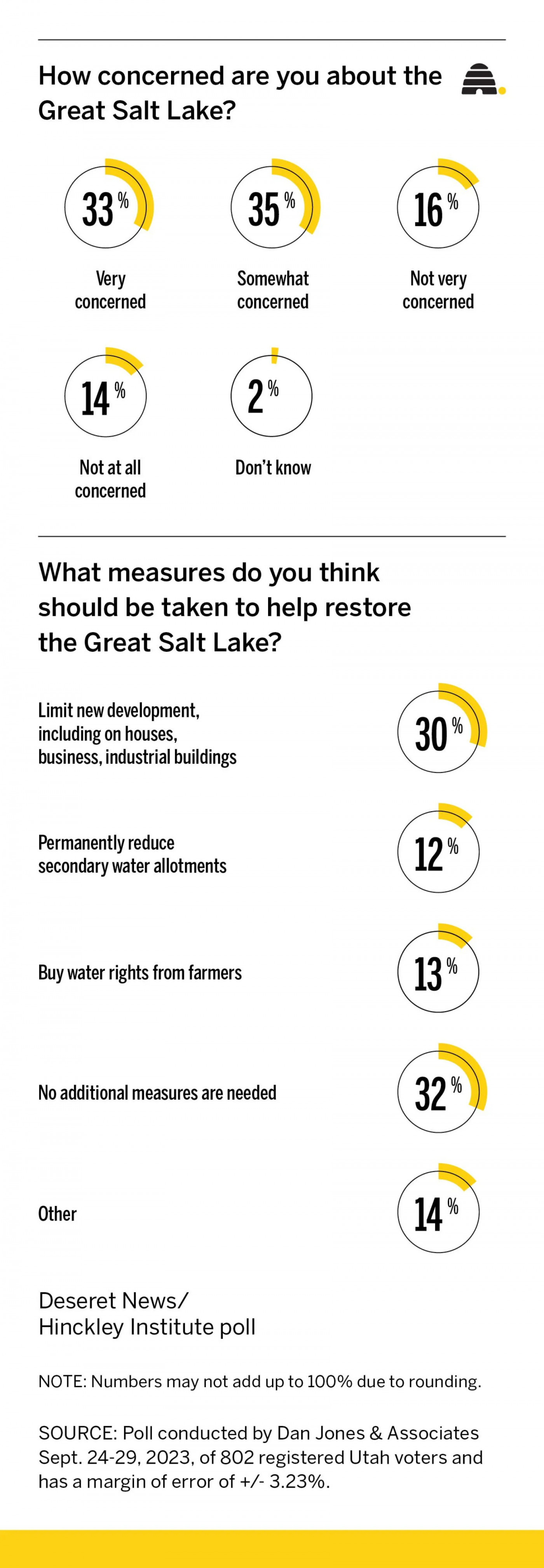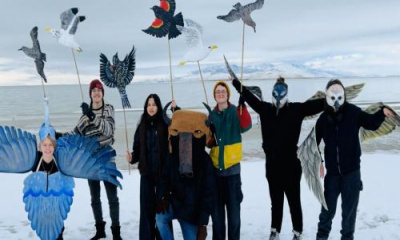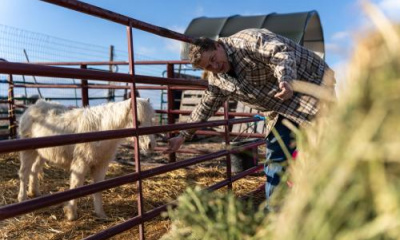It may have snowed and snowed and snowed some more last winter, but the record precipitation has done little to douse the concern a majority of Utah residents have over the Great Salt Lake’s condition.
The lake plunged to its lowest recorded level in November 2022 and has since come up a little more than 5 feet in its southern arm. That replenishment of water will not last, however, with losses due to evaporation.
A Deseret News/Hinckley Institute of Politics poll shows that 68% of those surveyed remain very concerned or somewhat concerned over the Great Salt Lake, but do not necessarily agree on how to restore it. Another 30% said they are not very concerned or not concerned at all. Two percent answered “don’t know.”
The survey was conducted Sept. 24-29, polled 802 registered voters and has a margin of error of plus or minus 3.23 percentage points.
The troubled saline lakes
The Great Salt Lake is among many saltwater lakes around the world that are in decline. It is the largest in the Western Hemisphere and is estimated to deliver $1.9 billion each year to Utah’s economy.
Its challenges due to diversion and drought have dropped the lake by at least 11 feet with more than 50% of its lakebed exposed. The Utah Division of Water Resources notes the lake has undergone drastic changes since 1875, when it was first monitored by the U.S. Geological Survey.
The decline has not only challenged wildlife and aquatic species, but poses a risk to human health with wind-whipped dust storms contributing to air quality challenges and earlier seasonal snowmelt.
Utah’s salty lake is not alone in its challenges, however. Iran’s Lake Urmia is in trouble and a Chilean lagoon has dried up. Diversions from Owens Lake in California landed it on the map at one time for being the nation’s largest source of PM10 pollution, or dust. It took years of work and $2.5 billion to clean up that mess.
While advocates and groups like the Great Salt Lake Advisory Council have been invested in solutions for years, Utah’s extreme drought galvanized state lawmakers and Gov. Spencer Cox into action, appropriating nearly a billion dollars over the last two years to boost water saving efforts, as well as making dramatic shifts in water policy. In November of last year, Cox issued a proclamation suspending any new water diversions in the Great Salt Lake watershed.
Still, some conservation groups filed a lawsuit against the state, alleging it had not done enough to protect it, demanding additional action. The September complaint asks that the Utah Department of Natural Resources review all upstream diversions impacting the Great Salt Lake.
With all the money that has been thrown at conservation and now with a pending lawsuit, the Deseret News poll asked what solutions the public has in mind for the lake.
Despite concern over the lake, 32% of people surveyed said no additional measures are needed to help, signaling perhaps public recognition of the steps Utah politicians have taken so far, or lake weariness.
The next largest response came in the form of limiting new development, including houses, businesses and industrial buildings, with 30% of the respondents settling on that measure to boost lake levels.
Breaking out that response by differing age groups, the largest percentage of people who favored those restrictions were in the 18-25 age range, landing at 43%. Support for that solution waned as the age of respondents increased. In the group of 57 and up, it had dropped to 25%.
Ari Bruening, president and chief executive officer of Envision Utah — a group promoting smart growth — said Utah faces tough choices with its booming economy and exploding population coupled with a housing shortage, and yet the desire to be good stewards of the environment at the same time.
“These are tough choices with real tradeoffs — and no easy solutions. It might sound tempting to limit development, but that’s much harder in the real world with existing property rights and ever growing population. And, let’s be clear, as long as Utah is a great place to live, it’s going to keep growing. Limiting housing might sound helpful for lake levels, but it doesn’t change the fact that Utah’s population is growing and would only make our housing shortage worse, driving up housing prices.”
Bruening said that other options contribute to solutions, such as water-wise landscaping and especially developing smaller lots.
Other ways to save the lake
Fourteen percent of those surveyed opted for some “other” solution, while 13% favor buying water rights from farmers and 12% favor reducing secondary water allotments.
As in the question about limiting development, the largest support for buying farmers’ water rights came from the younger crowd between 18 and 25, with 21% who favored that option. Support for that avenue had dwindled to just 8% for folks age 57 and up.
The poll comes as Utah heads into fall and what is hoped to be an active winter, helping to boost water levels not only for the Great Salt Lake but for its tributaries and drinking water supplies.







